Difference between revisions of "Patent leather"
m (→Cleaning and care of patent leather) |
|||
| (7 intermediate revisions by one user not shown) | |||
| Line 9: | Line 9: | ||
| − | == | + | ==What is patent leather?== |
| − | Patent leather is a [[Gloss of leather|high-gloss]], [[Leather grain - Grain side|grain-free]] leather, which has been [[finish|gloss-finished]] on the surface or [[Coated leather - Laminated leather|covered]] with a glossy, mirror-smooth film. Patent leather is used for [[leather shoes|shoes]], caps, [[leather clothing|clothing]], [[Leather wallets|wallets]] and [[Leather handbags|handbags]]. In the clothing sector, | + | Patent leather is a [[Gloss of leather|high-gloss]], [[Leather grain - Grain side|grain-free]] leather, which has been [[finish|gloss-finished]] on the surface or [[Coated leather - Laminated leather|covered]] with a glossy, mirror-smooth film. Patent leather is used for [[leather shoes|shoes]], caps, [[leather clothing|clothing]], [[Leather wallets|wallets]] and [[Leather handbags|handbags]]. In the clothing sector, lacquered leather is rather rare and is usually associated with [[Latex and leather|clothing for sexual preferences]]. Nowadays, you can see many high-gloss materials in the bag and shoe sectors. In the low price range, it`s mostly high-gloss [[imitation leather|artificial leather]]. |
| + | The origins of patent leather can be traced back to ancient Egypt. More than 4,000 years ago, the Egyptians used a technique called "faience" to glaze ceramic surfaces. This process was later used on leather to create a shiny effect. In ancient Greece and Rome, patent leather was widely used in shoes and clothing to create a luxurious and eye-catching look. | ||
| + | Patent leather continued to be popular in Europe during the Middle Ages and Renaissance. Patent leather manufacturing techniques improved, and the coatings were now often based on shellac, a resinous material derived from the excreta of lacquer scale insects. This method was used in many European countries, including Italy, France and England. | ||
| + | |||
| + | Patent leather peaked in popularity in the 18th and 19th centuries. During this period, new techniques were developed to create the glossy finish, including the application of oil paints and polishing with glass paste. Patent leather has been widely used in the fashion industry, especially for shoes, bags and [[leather accessories|accessories]]. | ||
| + | |||
| + | Patent leather was also used on uniforms. Patent leather was used in some armies for certain uniform parts, especially during the First and Second World Wars. Patent leather boots were particularly popular with officers and higher ranks as they gave a polished and representative look. However, patent leather was not used on all uniforms, but on certain uniforms such as guard uniforms. A well-known example of the use of patent leather in Guards uniforms is the British Queen's Guard standing outside the Royal Residences in London. The Queen's Guard [[leather boots|boots]] are made of patent leather, adding to the Guard's traditional and imposing appearance. | ||
| + | |||
| + | |||
| + | <p align=center> | ||
| + | [[bild:Lackleder-Schuhe-01.jpg|500px]] | ||
| + | </p> | ||
<p align=center> | <p align=center> | ||
| − | + | [[bild:Lackleder-Schuhe-03.jpg|500px]] | |
| − | [[bild:Lackleder-Schuhe-03.jpg| | + | |
</p> | </p> | ||
<p align=center> | <p align=center> | ||
| Line 21: | Line 31: | ||
<p> </p> | <p> </p> | ||
| − | Traditionally, high-gloss leather or patent leather | + | Traditionally, high-gloss leather or patent leather was worn on special occasions. Therefore, the leather did not develop [[leather damages|signs of use]] so quickly . Today, such leather is used every day as shoes or wallets. Wear correspondingly becomes visible faster. Other smooth leathers are similarly sensitive, but their softness and the matte surface mean that damage is less obvious. The eye perceives differences on gloss surfaces faster than on matte surfaces. With high-gloss varnishes, scratches and other damages should avoided as much as possible. |
<p align=center> | <p align=center> | ||
| − | [[bild:Handtasche-Lackleder-02.jpg| | + | [[bild:Handtasche-Lackleder-02.jpg|500px]] |
| − | + | ||
</p> | </p> | ||
<p align=center> | <p align=center> | ||
| − | ''[[Leather handbags|Handbag]] made of [[finish|high gloss finished]] leather. The [[Leather hair pores - Hair follicles|hair pores]] remain visible.''<br></p> | + | [[bild:Handtasche-Lackleder-03.jpg|500px]] |
| + | </p> | ||
| + | <p align=center> | ||
| + | ''[[Leather handbags|Handbag]] made of [[finish|high-gloss finished]] leather. The [[Leather hair pores - Hair follicles|hair pores]] remain visible.''<br></p> | ||
<p> </p> | <p> </p> | ||
<p align=center> | <p align=center> | ||
| − | [[bild:Tasche-Lackleder-02.jpg| | + | [[bild:Tasche-Lackleder-02.jpg|500px]] |
| − | [[bild:Tasche-Lackleder-01.jpg| | + | </p> |
| + | <p align=center> | ||
| + | [[bild:Patent-leather-bag-01.jpg|500px]] | ||
| + | </p> | ||
| + | <p align=center> | ||
| + | [[bild:Tasche-Lackleder-01.jpg|500px]] | ||
</p> | </p> | ||
<p align=center> | <p align=center> | ||
| Line 41: | Line 58: | ||
<p align=center> | <p align=center> | ||
| − | [[bild:lackleder.jpg| | + | [[bild:lackleder.jpg|500px]] |
| − | + | ||
</p> | </p> | ||
<p align=center> | <p align=center> | ||
| − | ''Neon green [[imitation leather]] with patent leather optics | + | ''Neon green [[imitation leather]] with patent leather optics.''<br></p> |
<p> </p> | <p> </p> | ||
==Crinkled patent leather== | ==Crinkled patent leather== | ||
| − | + | This is a patent leather, where the surface has been [[Boarded leather - Boarded grain|crumpled and creased]]. The effect is similar to that of [[embossed leather]]. The wrinkles are permanent. | |
<p align=center> | <p align=center> | ||
| − | [[bild:Knautschlack-vorher-01.jpg| | + | [[bild:Knautschlack-vorher-01.jpg|500px]] |
| − | [[bild:Knautschlack-nachher-01.jpg| | + | </p> |
| + | <p align=center> | ||
| + | [[bild:Knautschlack-nachher-01.jpg|500px]] | ||
</p> | </p> | ||
<p align=center> | <p align=center> | ||
| Line 61: | Line 79: | ||
==Cleaning and care of patent leather== | ==Cleaning and care of patent leather== | ||
| − | + | A damp cloth is sufficient to clean patent leather. In particular, light lacquer leather appears to have a [[leather damages#Dye transfer on leather|sensitivity to absorb dyes]]. Therefore, never store patent leather in dark bags, never put in plastic bags and never in contact with other leather bags. Transferred dyes penetrate the high-gloss surface like a tattoo and cannot be cleaned anymore. For Ballpoint pen marks or similar stains use cleaning spirit (try to cover the exposed area) to remove the discolouration before the dyes are absorbed. | |
| Line 68: | Line 86: | ||
</p> | </p> | ||
<p align=center> | <p align=center> | ||
| − | [[bild:Louis-Vuitton-Lackleder-verfaerbt-01.jpg| | + | [[bild:Louis-Vuitton-Lackleder-verfaerbt-01.jpg|500px]] |
| − | [[bild: | + | </p> |
| + | <p align=center> | ||
| + | [[bild:Patent-leather-10.jpg|500px]] | ||
</p> | </p> | ||
<p align=center> | <p align=center> | ||
| Line 75: | Line 95: | ||
</p> | </p> | ||
<p align=center> | <p align=center> | ||
| − | '' | + | ''Discolouration in patent leather by contact. Impossible to [[leather cleaner|clean]]. Louis Vuitton: New patent leather bag, even discoloured on both sides.''<br></p> |
<p> </p> | <p> </p> | ||
| Line 82: | Line 102: | ||
</p> | </p> | ||
<p align=center> | <p align=center> | ||
| − | ''Line from a permanent pen on patent leather. There is | + | ''Line from a permanent marker pen on patent leather. There is no way to remove by [[leather cleaner|cleaning]].''<br></p> |
<p> </p> | <p> </p> | ||
| − | Sometimes it happens that old patent leather becomes sticky with time. It must then be assumed that this is a decay process. Unfortunately, there is no solution to this problem. You can clean the leather with a [[leather cleaner|mild leather cleaner]] and wipe it with a cleaning spirit (test before!). For a moment, the stickiness decreases as long as the condition is not | + | Sometimes it happens that old patent leather becomes sticky with time. It must then be assumed that this is a decay process. Unfortunately, there is no solution to this problem. You can clean the leather with a [[leather cleaner|mild leather cleaner]] and wipe it with a cleaning spirit (test before!). For a moment, the stickiness decreases as long as the condition is not yet too bad. |
<p align=center> | <p align=center> | ||
| − | [[bild: | + | [[bild:Lackleder-klebt-10.jpg|500px]] |
| − | + | ||
</p> | </p> | ||
<p align=center> | <p align=center> | ||
| − | ''Older patent leather bag | + | [[bild:Lackleder-klebt-11.jpg|500px]] |
| + | </p> | ||
| + | <p align=center> | ||
| + | ''Older patent leather bag that has become sticky on its own. A repair is not possible.''<br></p> | ||
<p> </p> | <p> </p> | ||
<p align=center> | <p align=center> | ||
| − | [[bild:Lackleder-klebt-03.jpg| | + | [[bild:Lackleder-klebt-03.jpg|500px]] |
| − | + | ||
</p> | </p> | ||
<p align=center> | <p align=center> | ||
| − | ''The patent leather is glued | + | [[bild:Lackleder_klebt_04.jpg|500px]] |
| + | </p> | ||
| + | <p align=center> | ||
| + | ''The patent leather is glued and inseparable. It's too late for a rescue.''<br></p> | ||
<p> </p> | <p> </p> | ||
Important: Especially when old patent leather is treated with [[leather care|oils or grease based products]], the stickiness starts or is even reinforced. Patent leather does not need oil or grease (any kind of classic [[leather care]] including shoe polish) for conservation. The high gloss layer covers the surface of leather completely and does not allow the product to penetrate and reach the leather fibres. A care treatment would only make sense if the covering layer needed oil or grease. This is not the case. | Important: Especially when old patent leather is treated with [[leather care|oils or grease based products]], the stickiness starts or is even reinforced. Patent leather does not need oil or grease (any kind of classic [[leather care]] including shoe polish) for conservation. The high gloss layer covers the surface of leather completely and does not allow the product to penetrate and reach the leather fibres. A care treatment would only make sense if the covering layer needed oil or grease. This is not the case. | ||
| − | |||
| − | |||
== Additional information == | == Additional information == | ||
Latest revision as of 15:06, 12 June 2023
Contents
What is patent leather?
Patent leather is a high-gloss, grain-free leather, which has been gloss-finished on the surface or covered with a glossy, mirror-smooth film. Patent leather is used for shoes, caps, clothing, wallets and handbags. In the clothing sector, lacquered leather is rather rare and is usually associated with clothing for sexual preferences. Nowadays, you can see many high-gloss materials in the bag and shoe sectors. In the low price range, it`s mostly high-gloss artificial leather.
The origins of patent leather can be traced back to ancient Egypt. More than 4,000 years ago, the Egyptians used a technique called "faience" to glaze ceramic surfaces. This process was later used on leather to create a shiny effect. In ancient Greece and Rome, patent leather was widely used in shoes and clothing to create a luxurious and eye-catching look.
Patent leather continued to be popular in Europe during the Middle Ages and Renaissance. Patent leather manufacturing techniques improved, and the coatings were now often based on shellac, a resinous material derived from the excreta of lacquer scale insects. This method was used in many European countries, including Italy, France and England.
Patent leather peaked in popularity in the 18th and 19th centuries. During this period, new techniques were developed to create the glossy finish, including the application of oil paints and polishing with glass paste. Patent leather has been widely used in the fashion industry, especially for shoes, bags and accessories.
Patent leather was also used on uniforms. Patent leather was used in some armies for certain uniform parts, especially during the First and Second World Wars. Patent leather boots were particularly popular with officers and higher ranks as they gave a polished and representative look. However, patent leather was not used on all uniforms, but on certain uniforms such as guard uniforms. A well-known example of the use of patent leather in Guards uniforms is the British Queen's Guard standing outside the Royal Residences in London. The Queen's Guard boots are made of patent leather, adding to the Guard's traditional and imposing appearance.
Patent leather shoes of the highest price class. -Patent leather shoes embossed with foil lamination for 39,95 €.
Traditionally, high-gloss leather or patent leather was worn on special occasions. Therefore, the leather did not develop signs of use so quickly . Today, such leather is used every day as shoes or wallets. Wear correspondingly becomes visible faster. Other smooth leathers are similarly sensitive, but their softness and the matte surface mean that damage is less obvious. The eye perceives differences on gloss surfaces faster than on matte surfaces. With high-gloss varnishes, scratches and other damages should avoided as much as possible.
Handbag made of high-gloss finished leather. The hair pores remain visible.
Foil Laminated handbag. The hair pores are completely covered.
Neon green imitation leather with patent leather optics.
Crinkled patent leather
This is a patent leather, where the surface has been crumpled and creased. The effect is similar to that of embossed leather. The wrinkles are permanent.
Patent leather converts to crinkled patent leather.
Cleaning and care of patent leather
A damp cloth is sufficient to clean patent leather. In particular, light lacquer leather appears to have a sensitivity to absorb dyes. Therefore, never store patent leather in dark bags, never put in plastic bags and never in contact with other leather bags. Transferred dyes penetrate the high-gloss surface like a tattoo and cannot be cleaned anymore. For Ballpoint pen marks or similar stains use cleaning spirit (try to cover the exposed area) to remove the discolouration before the dyes are absorbed.
Discolouration in patent leather by contact. Impossible to clean. Louis Vuitton: New patent leather bag, even discoloured on both sides.
Line from a permanent marker pen on patent leather. There is no way to remove by cleaning.
Sometimes it happens that old patent leather becomes sticky with time. It must then be assumed that this is a decay process. Unfortunately, there is no solution to this problem. You can clean the leather with a mild leather cleaner and wipe it with a cleaning spirit (test before!). For a moment, the stickiness decreases as long as the condition is not yet too bad.
Older patent leather bag that has become sticky on its own. A repair is not possible.
The patent leather is glued and inseparable. It's too late for a rescue.
Important: Especially when old patent leather is treated with oils or grease based products, the stickiness starts or is even reinforced. Patent leather does not need oil or grease (any kind of classic leather care including shoe polish) for conservation. The high gloss layer covers the surface of leather completely and does not allow the product to penetrate and reach the leather fibres. A care treatment would only make sense if the covering layer needed oil or grease. This is not the case.
Additional information








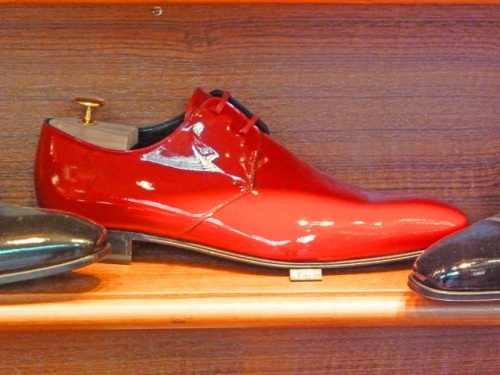
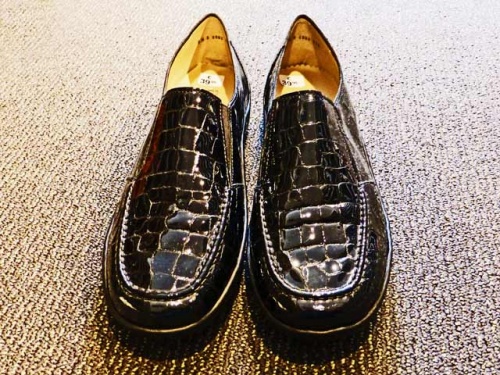
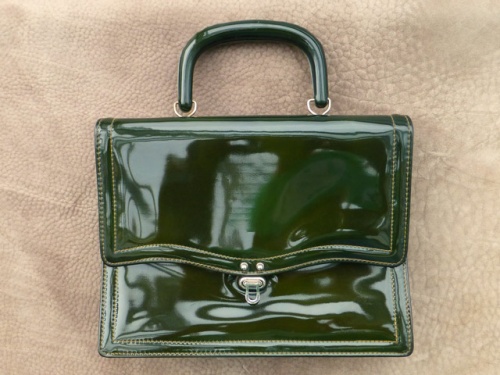
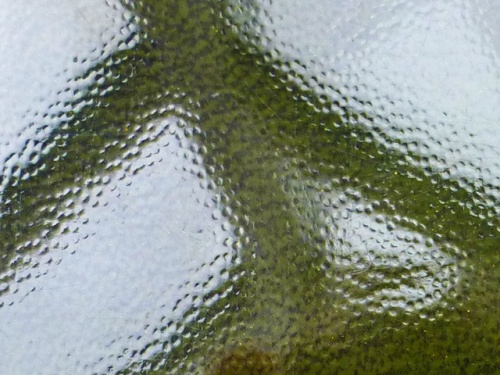
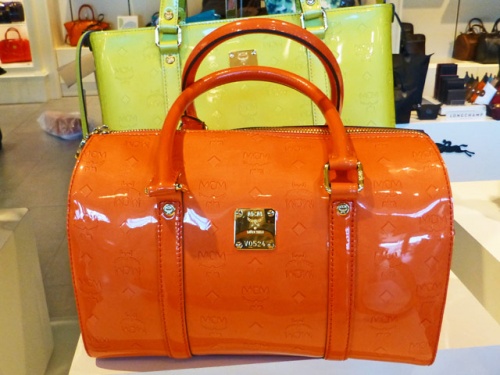
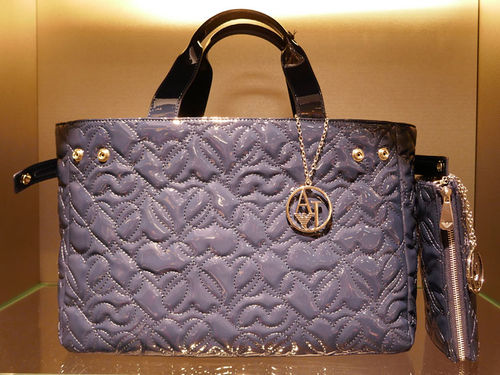
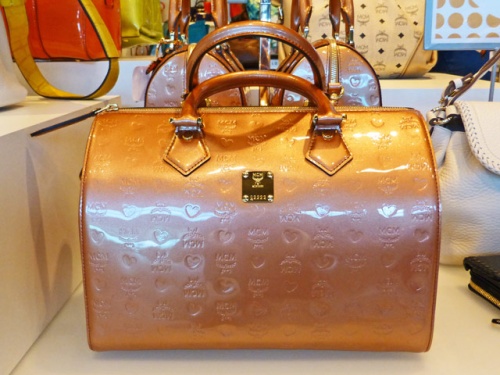
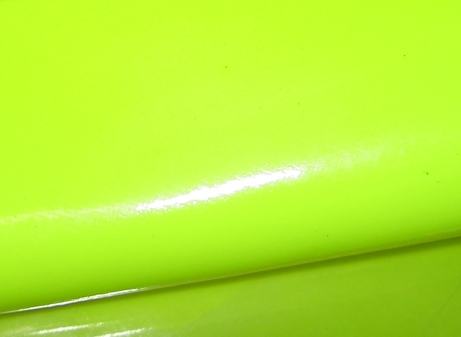
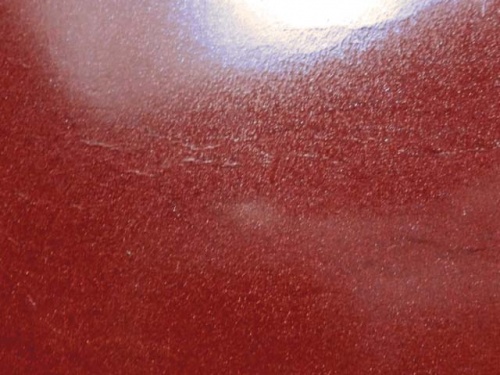
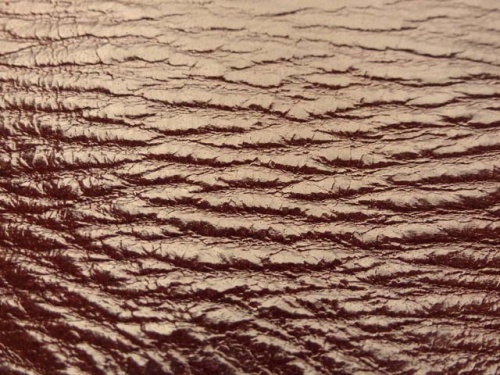

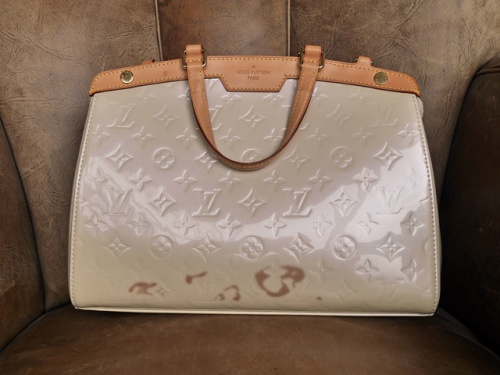
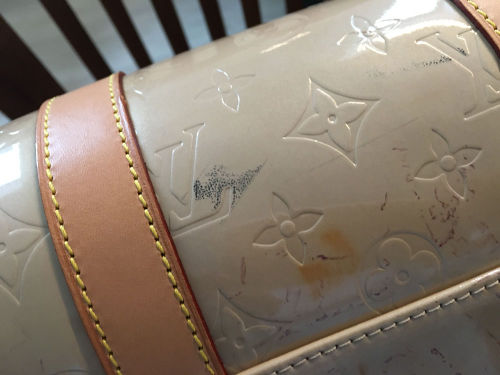


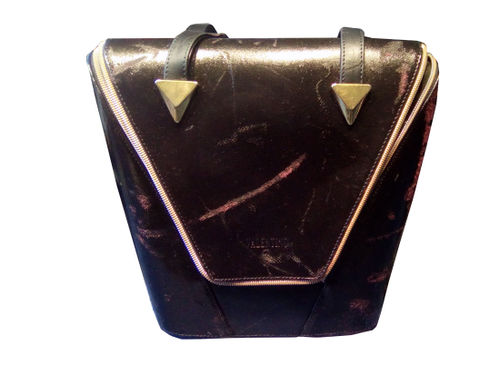
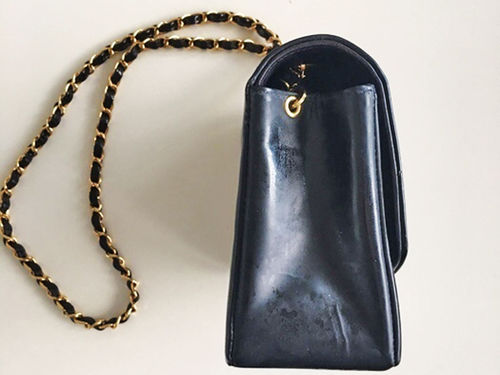
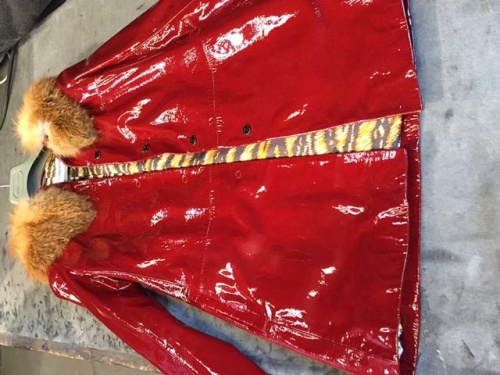
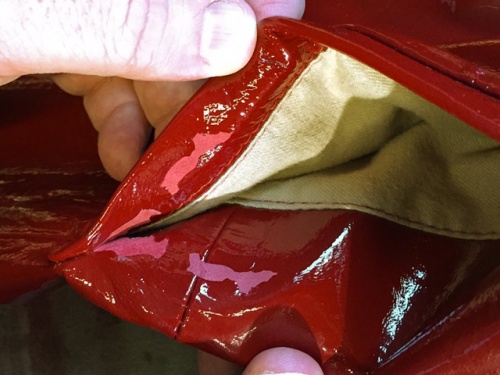

 a kotori web solution
a kotori web solution